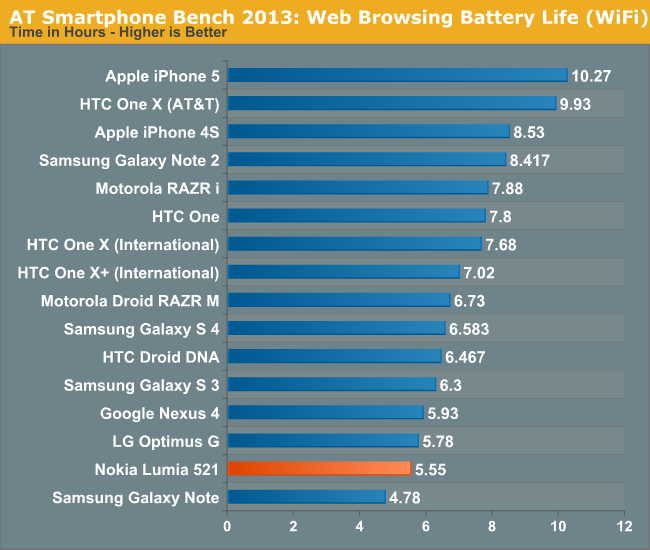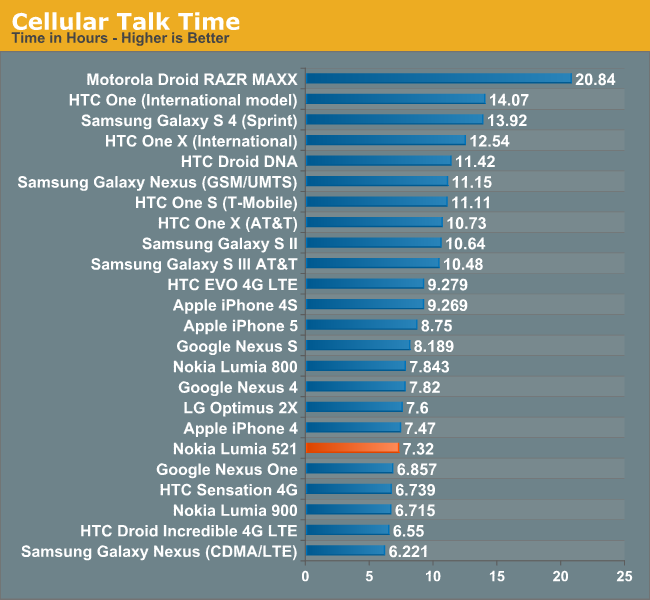Nokia Lumia 521: Quality Smartphone on an Extreme Budget
by Vivek Gowri on August 8, 2013 1:08 AM EST- Posted in
- Smartphones
- Nokia
- Mobile
- windows phone 8
- Lumia 520
- Lumia 521
There are a lot of things about this phone that remind me of the legendary Nokia brick phones of old. Battery life is absolutely not one of them. This is the first time I’m getting the chance to fully test battery life on a Windows Phone 8 device. Until now, I haven’t seen the option to set display timeout to “never” on one of the Nokia devices—the maximum was 5 minutes on the 920, 820, and 810. The 521 has a 1430 mAh 3.7V battery, putting it at 5.29 Wh—a far cry from the 9+ Wh batteries we see in a lot of higher end phones these days. This results in battery life being...not great—easily one of the poorest results we’ve seen in the 2013 Smartphone Bench after the original Galaxy Note and the notoriously short-lived Galaxy Nexus.
It’s worth noting, too, that the 521 is using single-carrier HSPA+ as the air interface during our mobile broadband test. That’s technically 4G, but obviously offers less bandwidth than the DC-HSPA+ we’re used to seeing on T-Mobile.



I did the battery life testing at the medium brightness setting (191 nits), since that was the closest to the 200 nits we use as the baseline and well within the margin of error. Talk time is a bit more respectable, indicating that the display and backlight are perhaps a bit less efficient than in other devices.
When you think about these results in the context of the battery capacity, the 521 is actually pretty efficient from a power standpoint. Obviously, with a dual-core CPU clocked so low combined with a relatively small display, this makes sense; I just wish that Nokia had specced at least a slightly larger battery to get more competitive runtimes.










116 Comments
View All Comments
Death666Angel - Thursday, August 8, 2013 - link
Huh, wasn't even aware of this phone. That's pretty good value for 140€. If my wife didn't have a Chinese phone since Christmas, I'd get her one of these.Gunbuster - Thursday, August 8, 2013 - link
I love this little phone. Having jumped on the deal at HSN for $80 I could destroy this phone 6 times over and still be ahead of buying a "high end" handset.You get 90% the capabilities of better phones at a price that is over 80% lower.
kmmatney - Thursday, August 8, 2013 - link
Can you use the AT&T GoPhone version with a normal regular AT&T plan? I'm tempted to sell my 4S 32GB before before the new iPhones come out, and use this for a while.thesavvymage - Thursday, August 8, 2013 - link
yeah you just pop in the SIM and it will work since it is compatible with AT&T's frequenciesImpulses - Friday, August 9, 2013 - link
At one point in time AT&T actually flagged GoPhone IMEIs and wouldn't let you use them with pre-paid plans tho, this was a few years ago, no clue if it's still in practice.jabber - Thursday, August 8, 2013 - link
Must admit at 1:1 the pics from the 520/521 look better than the pics taken with the Nexus 4 at 1:1VivekGowri - Thursday, August 8, 2013 - link
Yeah, I wouldn't disagree with that statement.Azurael - Friday, August 9, 2013 - link
The Nexus 4's camera is notoriously bad though. I don't know what LG were thinking! It's the only thing that's even giving me thoughts about upgrading to one of this year's latest and greatest handsets. Certainly not the 400+ PPI I can't discern displays or swanky new SoCs (which are only marginally faster than the S4 Pro in the N4 but driving 1920x1080)Then I remind myself that ALL mobile cameras, regardless of how 'good' they look AS mobile cameras - Nokia Pureview being a possible excepetion - are dreadful compared to the cheapest 1/2.3" sensor-equipped compact cameras, let alone anything better with a larger sensor. In fact, when I did have a phone with a better camera (One X), I didn't use it any more than I do with the terrible camera in the N4 now.
ljlego - Thursday, August 8, 2013 - link
"Far too often, you see important functions and options pushed into random corners of the interface, buried deep in some menu."That's a pretty bold claim that I have never experienced, personally. Could you maybe provide an example of when you've found this?
Collin5 - Thursday, August 8, 2013 - link
@VivekA well done review! It is balanced and it includes a lot of useful information not found anywhere else. Thank you!
However, I also feel there are a few statements, related to multitasking and overall performance, which paint a picture with too broad a brush. Nothing critical or wrong, but something you may want to look into for future reviews of WP devices:
1)
"Multitasking in Windows Phone has never really sat well with me, because it’s not really multitasking in the traditional sense—the need to completely close and rehydrate tasks makes resuming applications exceedingly slow."
On my Lumia 520 app switching occurs instantaneously most of the time. Only when I open more apps than the device can fit into RAM, is the least frequently used app completely closed out (tombstoned). Only when switching back to a tombstoned app does the rehydration process kick in (which I agree is too lengthy). However, even the Lumia 520 can simultaneously cache two or three apps in memory, which is enough to get through most multitasking scenarios without tombstoning occurring.
Saying that "the need to completely close and rehydrate" is too much of a blanket statement. That need only exists in very specific circumstances, which some may encounter only very rarely (depending on how people use their device).
2)
"...but in day to day use, it mostly makes itself felt in slower application loading and multitasking/task switching, which is also related to having just 512MB RAM instead of the 1GB of the 920."
This could be understood to imply that having less RAM negatively impacts the time it takes to load apps AND the time it takes to task-switch between them, which is false. Having less RAM has no affect on app load times. Having less RAM also has no direct impact on the time it takes to switch between apps. Having less RAM only has an indirect affect on task-switching in the way I already mentioned... RAM capacity determines how soon apps are tombstoned. That is all. Both app load times and rehydration (basically the same thing) are directly impacted by the slower CPU however.
Certainly we can argue that the probability of a task requiring rehydration is greater on a 512 MB device, but that is what I would expect an article on Anandtech to explicitly state, instead of attributing app load performance directly to RAM capacity ;-)